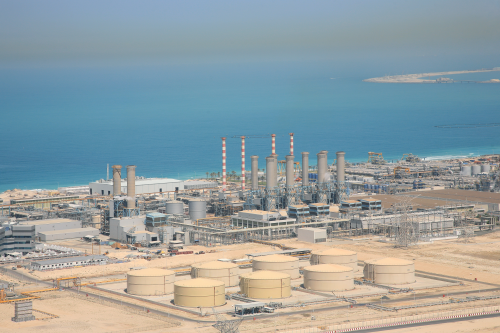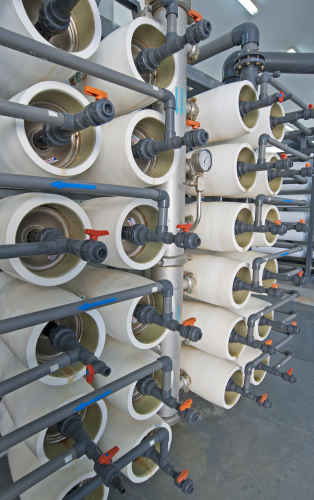




Current issues
Various issues and drivers are accelerating the development of desalination systems and these will continue to have an increasing impact in the coming decades. Climate change, surging population growth, urban development, and industrialisation will increase the worldwide demand for fresh water and, therefore, will drive the need to exploit new sources of water. We can view the desalination developments necessary to keep pace with this change as critical in enabling a sustainable future for all, as the reliable and affordable supply of fresh water is the main consideration for humanity. Leon Awerbuch reinforced this critical issue. “Water scarcity is a major global challenge,” he explained, “and it is the hope of future generations that desalination can solve regional and international conflicts by providing reliable new water at a price affordable to the global population.”“Desalination has decisively proven, during the last forty years, its reliability to deliver large quantities of fresh water from the sea, from brackish resources and through water reuse,” Awerbuch went on to explain, “so we can no longer view fresh water as an infinitely renewable resource because, unlike oil, fresh water has no viable substitute.” “The sea is the unlimited source from which we can create new fresh water through desalination,” Awerbuch said, “and seawater desalination offers the potential for an abundant and steady source of fresh water purified from the vast oceans.” Although the use of seawater desalination must be considered after all other arguably cheaper water source options have been implemented, Awerbuch asserts that “seawater desalination should be viewed as a crucial component in the portfolio of water supply options.”For water-scarce countries such as Dubai that already implement all other measures for fresh water generation, desalination may serve as the only viable means to provide the water supply necessary to enable sustainable development and support population growth. “As you probably know,” Awerbuch went on to say, “a significant amount of desalinated water is already produced worldwide.” He explained that the 24th Global Water Intelligence and IDA Worldwide Desalting Plant Inventory indicates that the total capacity of all desalination plants stands at 77.4 million cubic metres per day, and that there are now 16,000 desalination plants worldwide in 150 countries.We asked Karl Millauer what the current technical issues were. He outlined various aspects including the need to develop new ways of reducing biofouling of membranes, the importance of protecting seawater reverse osmosis (SWRO) systems from the red blossom algae problem, and the need to treat brine reject for beneficial use. He also identified the need to drive down the capital cost of thermal desalination systems but especially confirmed that the industry “needs to drive down energy costs, especially for SWRO.” Awerbuch very much agreed on the cost issue. “We still face challenges and despite major advances in desalination technologies,” he explained, “seawater desalination is still more energy intensive compared to conventional technologies for the treatment of fresh water. There are also concerns about the potential environmental impact of large-scale seawater desalination plants.” For these reasons the IDA has recently created the Energy and Environment Task Force (EETF). Despite dramatic progress in recent years, with the power consumption of seawater desalination reducing to around 3 kWh/m3 treated water for RO and to typically 1 kWh/m3 (plus heat) for multi-effect distillation (MED) processes, the IDA established the EETF to educate the global population as well as to set the challenging target of achieving a further 20% reduction in energy consumption for all major desalination processes by 2015. “The challenge for the task force is establishing rapid progress on green desalination with minimum chemicals and low carbon footprint,” Awerbuch explained, “but maybe the most important challenge is to reduce further the total cost of desalination.” According to the IDA, the total cost in 2012 of producing a cubic metre of fresh water from seawater, including energy, capital and all operational costs, is typically in the range of US$ 0.5 to US$ 1.5 for every 1000 litres produced. Hence, on average all 7.5 billion people in the world’s population could theoretically get 10 litres of clean water each a day from existing desalination plants alone, for a cost of just one US cent each per day. Awerbuch added: “Our goal should be to find new solutions to bring the price of desalinated water to a level of US$ 0.25 per 1000 litres.”
Changes on the horizon
So, how are the issues we have investigated above likely to drive the desalination industry over the next ten years? We posed this question to Millauer and Awerbuch.In terms of finding beneficial uses for brine reject, Millauer thought that purification of brine for use as salts and road salts would be important, as well as providing a feedstock for the chemical industry. He also predicted further advances in the application of forward osmosis (FO) technology, with developments in stand-alone systems, or in conjunction with RO, leading to lower energy consumption. To further reduce energy consumption, “the utilisation of waste heat in desalination systems,” Millauer explained, “will lead to much lower operational costs.”He added: “Dissolved air flotation systems will protect against red algae blossoms, and we will also see a breakthrough with technologies such as coated membranes to reduce drastically membrane fouling.”Awerbuch went on to explain that “the nexus of water and energy as well as environmental impact is now a focus of governments, universities, R&D clusters, engineering companies, suppliers of technology and utilities. With education of the public we will have global support and we will be able to solve these challenges.”New challenges are already on the horizon, such as how to couple efficiently renewable energy sources and heat from nuclear energy with desalination systems, the use of desalination techniques in solving industrial waste water problems, and the reusing and recycling of water from the petroleum and mining industries. For example, hydraulic fracturing (involving the use of high-pressure water, sand and chemicals that break open rock seams, making it easier for natural gas extraction) coupled with horizontal drilling, is largely responsible for a boom in US natural-gas production. Awerbuch said: “Energy experts predict that the US has several decades of natural gas supplies locked underground. One of the most contentious issues in the debate over shale gas drilling - how to handle millions of gallons of contaminated wastewater - remains unsettled.” Awerbuch also thought that we will see the large scale demonstration of Desalination Aquifer Storage and Recovery (DASR) in the next ten years, as an economic and strategic method of balancing the variability of seasonal power changes with fluctuating water demand. There are numerous examples of aquifer recharge by desalination technologies already employed in water reuse systems such as the Groundwater Remediation Scheme in Orange County, US.“The challenges will see the development of new technologies,” Awerbuch added, “like forward osmosis, osmotic power, membrane distillation, membrane nanotechnology and more futuristic ideas of desalination like bio-engineered bacteria able to eat specific ions and eat salt.”
Main developments predicted in large scale SWRO
In large scale SWRO plants, defined as those producing over 250,000 m3 per day of fresh water, we will see a further reduction in energy costs per unit desalted water. Millauer said this would be due to, “more efficient energy recovery, the introduction of new types of membranes and faster flows in RO plants.” It is also likely that new types of membranes will be much more fouling resistant.Millauer added: “We will also see the use of waste heat from power plants for use in desalination, a reduction in material costs (and hence CAPEX) of thermal desalination plants by the use of less expensive coated materials, and further recovery of brine.”The IDA confirms that a number of these large scale SWRO plants are already under construction. Awerbuch said that “Many of the plants in the Middle East will be built as integrated hybrid solutions where the best properties of thermal process are combined with the best features of membrane technology.” This would provide optimum solutions for power production and the production of fresh water from desalination systems. Awerbuch added: “These hybrid projects will combine power generation with MED, and nanofiltration and RO systems will be added to raise efficiency and recovery.” It is likely that we will see the efficiency of all desalination plants significantly increase. For example, Awerbuch predicts that we will see large MED plants with gain output ratios (GOR) of 15-20. This means that they will produce 15-20 tonnes of water per each tonne of steam used, compared to a typical GOR of 10 today. MED capacity is also likely to grow from 8.5 MGD to 20 MGD per typical plant. In RO we will most likely see larger modules with membrane elements of 16 inch diameter and above, their use bringing a reduction in cost and space requirements. Despite improvements in thin-film composite membranes over recent years Awerbuch commented that “there are still shortcomings which will be improved. There will be high temperature membranes which can increase fluxes and recovery at 50°C and above.” Larger RO trains and improved fouling resistance will have the effect of increasing energy efficiency, reliability, and the environmental impact of these much larger SWRO systems. “New technologies for pre-treatment and post-treatment,” Awerbuch explained, “as well as new designs for intake and outfall structures, will increase recovery and minimise environmental impact.” “We will expect to see large scale solar desalination with solar towers, concentrated solar power and solar photovoltaic coupling to seawater desalination. At the end of the decade, I think that coupling of nuclear energy and desalination will be possible.”
Main developments predicted in small scale SWRO
In small scale desalination systems, such as re-locatable systems and those used in remote locations or on offshore and marine applications, there is likely to be dramatic growth in the application of renewable energy such as the use of solar, wind and geothermal technologies.Millauer told us that there is likely to be more containerised and standardised solutions, produced in much larger quantities. “These will be either modular or mobile,” he said, “powered by solar energy or the use of waste heat. With waste heat utilisation, OPEX and CAPEX can be considerably reduced.”“For marine applications and offshore platforms,” he added, “reduction of footprint and weight is an important factor. For remote locations you need energy supply options, and it will be important that the CAPEX can be reduced, which should be possible by the economies of scale effect.”Awerbuch thought that we will see development of membrane distillation, forward osmosis and package thermal MED. “Humidification and dehumidification of air will find its application,” he said, “and small systems for marine and remote locations will be the norm primarily with RO or FO and membrane distillation.”
Use of alternative water sources
“There is no question there will be exponential growth in the application of desalination technologies for water reuse”, Awerbuch predicted. The effective use of membrane bioreactors, UF and RO technologies will dramatically increase the number and size of water reuse projects. “I can envisage direct coupling of advanced water reuse treated water with seawater desalination,” Awerbuch added, “as a means of reducing energy and cost. The use of desalination technology will be broadly applied to municipal, industrial and agricultural wastewater for recycling. I can see in the next ten years desalinated wastewater will be used for blending in aquifers or for direct municipal water supply.”
The longer view
Millauer acknowledged the established problem that “it is difficult to enter the water market with new technologies as clients tend to be conservative.” Awerbuch agreed but said that “with rapid change in technology and great innovation even the conservative water industry will change dramatically in ten years.”“In ten years,” Millauer predicted, “forward osmosis will already have an increased market share.” We predict this will continue to increase over a twenty year period. Over this longer period Millauer thought that there would be further reductions in energy costs, more effective and efficient membranes (with less biofouling) and, as highlighted by Awerbuch, more hybrid (thermal and RO) desalination plants.“It’s difficult to say what will happen in twenty years but I am sure RO will still be the leading technology but with different components,” Millauer added.“Beyond that horizon,” Awerbuch hypothesised, “new breakthroughs in biology and genetics, and the use of new energy sources, open great possibilities for new technologies that mimic nature. For example, an emerging technology for ultra-high permeability membranes is based on incorporating aligned nanotubes or aquaporins into a barrier matrix. Carbon nanotube membranes have demonstrated the most potential so far.”
Training for the future
We have seen that significant developments are very likely in the application of desalination technology over the next ten to twenty years despite the water industry’s generally conservative nature. In order to facilitate this change increased research and development activities will obviously need to be undertaken, but these will need to be firmly underpinned by highly skilled leaders. To fill this potential skills gap, more effective coordinated training and development opportunities will be required such as those about to be made available through the IDA’s new Desalination Academy. This is billed by the IDA as being “the premier global training institution focused on desalination and water reuse.” Inaugural IDA Desalination Academy courses will be featured during Singapore’s International Water Week in July 2012. The academy aspires to increase knowledge that leads to innovation. The academy will “create a platform for sharing ideas, building new connections and exchanging insights as participants enhance their skills and expand their professional development.” The focus at the academy needs to be a common theme throughout the desalination industry. This is not only to focus on increasing practical skills and knowledge but putting these advances into a broader context, so that everyone involved in today’s desalination industry plays an important role in shaping the world’s water solutions for future generations. As we said at the start of this article, ensuring the fair and equitable supply of fresh water to all communities is the most critical challenge facing humanity, for without fresh water we cannot survive. Current and future leaders in the application of desalination technology have an incredibly important and pivotal role to play.






